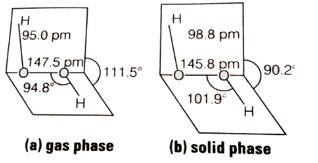Chemistry NCERT Exemplar Solutions Class 11th Chapter Nine
Get insights from 89 questions on Chemistry NCERT Exemplar Solutions Class 11th Chapter Nine, answered by students, alumni, and experts. You may also ask and answer any question you like about Chemistry NCERT Exemplar Solutions Class 11th Chapter Nine
Follow Ask QuestionQuestions
Discussions
Active Users
Followers
New answer posted
5 months agoContributor-Level 10
This is a short answer type question as classified in NCERT Exemplar
Dihydrogen reacts with dioxygen to form water. The reaction is highly exothermic.
H2 (g) + O2 (g) → H2O (l)
? H = -285.9KJmol-1
The isotope of hydrogen which has one proton and one neutron is deuterium. When it reacts with O2 it forms Deuterium oxide (D2O). Deuterium reacts in a similar way but the reactivity will be lesser than hydrogen because of high bond dissociation enthalpy of D2 as compared to hydrogen.
New answer posted
5 months agoContributor-Level 10
This is a short answer type question as classified in NCERT Exemplar
D2O has greater intermolecular force of attraction. This is because D2O exhibits higher values for melting point, enthalpy of vaporization, and viscosity compared to H2O, indicating stronger intermolecular interactions needed to overcome these properties.
New answer posted
5 months agoContributor-Level 10
This is a short answer type question as classified in NCERT Exemplar
In H2O2 oxygen is in -1 oxidation state which has tendency to become -2 that is why it is a better oxidising agent than water.
New answer posted
5 months agoContributor-Level 10
This is a short answer type question as classified in NCERT Exemplar
2H2O2 → 2H2O+O2
5 volume H2O2 means IL of H2O2 will give 5L of O2 at STP.
On the basis of the equation it is clear that 22.7 L of O2 is produced by 68 g of H2O2.
5L of O2 is produced by = = = g of H2O2=14.9g
i.e. 15 g H2O2 dissolved in 1 L solution will give 5 L oxygen or 1.5 g H2O2/100 mL solution will give 500 mL oxygen. Thus 15 g/L or 1.5% solution is known as the 5V solution of H2O2.
New answer posted
5 months agoContributor-Level 10
This is a short answer type question as classified in NCERT Exemplar
Peroxodisulphate, obtained by electrolytic oxidation of acidified sulphate solutions at high current density, on hydrolysis yields hydrogen peroxide.
2HSO4- (aq) → HO3SOOSO3 2HSO4- (aq)+2H+ (aq)+H2O2 (aq)
This method is now used for the laboratory preparation Of D2O2.
K2S2O8 (s)+2D2O (l) → 2KDSO4 (aq)+D2O2 (l)
New answer posted
5 months agoContributor-Level 10
This is a short answer type question as classified in NCERT Exemplar
Heavy water can be made by electrolyzing water repeatedly or as a by-product in the fertiliser industry. It's a deuterium compound that's used to make other deuterium compounds.
Physical Properties of H2O and D2O
Property | H2O | D2O |
Molecular mass (g mol-1) | 18.015 | 20.0276 |
Melting point/K | 273.0 | 276.8 |
Boiling point/K | 373.0 | 374.4 |
Enthalpy of formation/kJ mol- | -285.9 | -294.6 |
Enthalpy of Vaporisation (373 K)/kJ mol-1 | 40.66 | 41.61 |
Enthalpy of fusion/kJ mol-1 | 6.01 | — |
Temp of max. density/K | 276.98 | 284.2 |
Density (298 K)/g cm-3 | 1.0000 | 1.1059 |
Viscosity/centipoise | 0.8903 | 1.107 |
Dielectric constant/C2/N.m2 | 78.39 | 78.06 |
New answer posted
5 months agoContributor-Level 10
This is a short answer type question as classified in NCERT Exemplar
(a) Electron deficient hydrides are those that lack sufficient number of electrons to form typical covalent bonds. Group 13 hydrides, for example (BH3, AlH3, etc.).
(b) Electron precise: Electron precise hydrides are those that have the exact number of electrons required to form covalent bonds. Group 14 hydrides, for example (CH4, SiH4, GeH4, SnH4, PbH4 etc.). They are tetrahedral in shape.
(c) Electron rich hydrides: Electron rich hydrides are those that have more electrons than are required to create conventional covalent bonds. Hydrides of groups 15 to 17. (NH3, PH
New answer posted
5 months agoContributor-Level 10
This is a short answer type question as classified in NCERT Exemplar
Water demineralization using organic or synthetic ion exchange resins (ion exchange resins):
a. Synthetic resins are insoluble polymeric solids that contain a large hydrocarbon network with reactive acidic or basic groups.
These are better than Zeolite since they can remove all kinds of cations and anions from water. Demineralised or deionised water is the product of this process.
b. There are two categories of these:
Resins for cation exchange: Acidic groups such as COOH or SO3H can be found in them. Resin-H+-can be used to represent them.
Mg2+
New answer posted
5 months agoContributor-Level 10
This is a short answer type question as classified in NCERT Exemplar
Self ionization of water is known as autoprotolysis of water.
H2O (l) + H2O (l) → H2O2 (aq) + OH- (aq)
Acid Base Conjuga
New answer posted
5 months agoContributor-Level 10
(i) During winter, the temperature of lake water keeps on decreasing. Since cold water is heavier, it moves towards the bottom.
(ii) Density of ice is less than that of water that is why it floats on the surface of water.
Taking an Exam? Selecting a College?
Get authentic answers from experts, students and alumni that you won't find anywhere else
Sign Up on ShikshaOn Shiksha, get access to
- 65k Colleges
- 1.2k Exams
- 679k Reviews
- 1800k Answers

